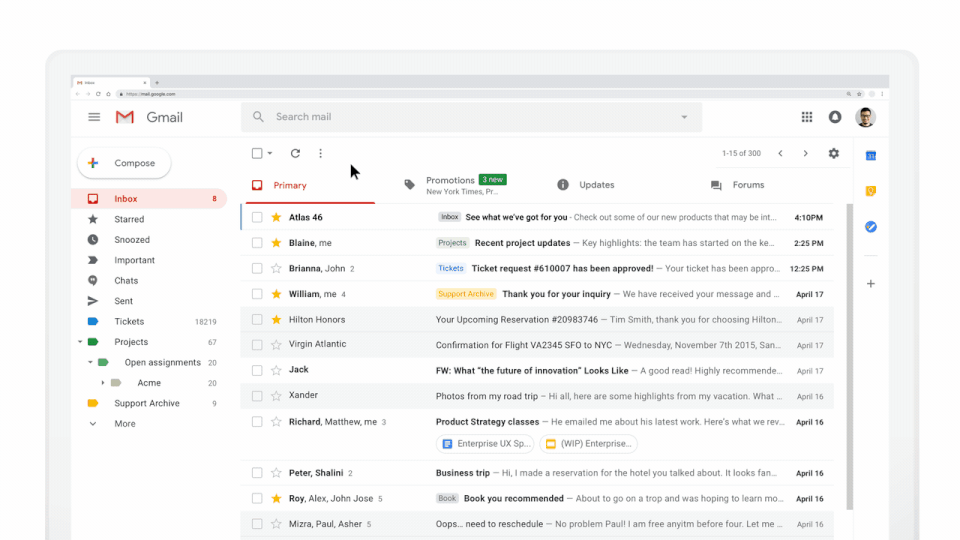AMP: The Future of Email

Dynamic email created using AMP technology by Russian developers from ecwid.ru
The AMP project was designed to improve the user experience on the web, which means working with e-mail when it happens on the web. For most of us, e-mail functions have hardly changed since its inception (most of us, obviously, did not see this appearance). Well, the essence of AMP in ensuring speed and security, so it was impossible not to develop AMP for e-mail . It would seem that JavaScript in the mail can be a good idea, but thanks to the AMP framework, users can interact with real-time emails without fear for the security of their data.
"How?" - you ask? The answer is under the cut
Thanks to AMP, users have completely new opportunities to interact with the mail: now you can respond to invitations, fill out questionnaires, browse through catalogs or leave comments directly in the body of the letter. In addition, now with the help of letters you can follow the updates, whether it is new comments in the topic or the latest recommendations.
AMP technology in emails of the largest postal services
AMP technology in e-mails began to be used by the largest postal services around the world, including Gmail, Mail.Ru, Yahoo! Mail and Outlook.com. As they launch support for this format, senders expand the audience reach for AMP letters. Mail.ru also offers its editor , but more on that later.
Initially, only the most active users could use the version for developers, but now AMP technology for emails is available to all recipients and any sender interested in. Some good examples can be found in the official Google blog . In addition, additional information can be found on the pages of other mail services:
- Mail.ru
- Yahoo Mail
- Outlook.com
- Also in the Ecwid and OYO Rooms blogs.
We are committed to providing high quality email to our users, and we are pleased to be one of the first services that support AMP e-mail technology. This allows us to create the conditions for fast and efficient work of e-mail - Marcel Becker, Director of Product Management, Yahoo! Mail
If you are submitting a postal service and you want to add support for AMP technology for emails, check out the detailed information here .
Create AMP letters now
Test sites for creating AMP-letters is no longer one. As we have said, the Playground provides Mail.ru. Well, we’ll take a closer look at the test site from the AMP project itself on amp.dev. allows you to edit markup and track changes in real time. For more information on the supported functions and syntax, see the link . But there is nothing difficult in this process:
<!doctype html> <html amp4email> <head> <meta charset="utf-8"> <script async src="https://cdn.ampproject.org/v0.js"></script> <style amp4email-boilerplate>body{visibility:hidden}</style> </head> <body> Hello, AMP4EMAIL world. </body> </html> As you can see, this is completely normal HTML, but amp4email should be added to the html tag, and of course, do not forget the AMP library itself - <script async src = " https://cdn.ampproject.org/v0.js "> </ script> . And then everything is simple. If you are already familiar with AMP, you will find all your favorite tags, such as amp-img and amp-carousel . And if this framework is new to you or your knowledge is podzarzaveli, then you are here .
"But after all, the promised salt of AMP mail is dynamic, and where is it?" - you ask. In amp-bind , where else! We will not rewrite all the documentation here, but if you have questions, we wait in the comments!
If a third-party company is sending you email, you need to make sure that it supports AMP. The following services already support the AMP specification or are actively working on the implementation of this technology:
- SparkPost - email service and analytical platform
- Litmus - a toolkit for marketing and email design
- Twilio Sendgrid is a platform for sending transactional and marketing mailings, which is used by more than 80,000 companies.
- Amazon SES and Amazon Pinpoint - Cloud Email Services and Analytics
- And other services working to support this technology. Contact your email service for details.
AMP letters are compatible with the current email ecosystem thanks to a new part of the MIME standard . Thus, if the email client does not yet support AMP letters, such a letter will be shown in HTML format. More information about the characteristics, as well as instructions can be found here . We are looking forward to feedback from both users and developers.
New working group of AMP letters
For AMP mail to continue to grow for the benefit of users, we need your help. Therefore, within the AMP management model and as a channel, a special working group on the development of AMP technology for emails was created to receive feedback from senders and mail services. This group has two tasks:
- Encourage the exchange of knowledge about AMP-letters between postal services to ensure compatibility of various e-mail services.
- To organize a channel for transmitting user feedback and community to senders and postal services in order to develop and improve technology.
If you are submitting an email service, sending emails, or just want to join the AMP technology development working group , you can participate in the discussion of issues on the ampproject / wg — amp4email repository or join the # wg — amp4email channel on Slack.
Open source software, support from multiple vendors, a gradual migration strategy and an open working group that listens to everyone will help us create a new generation of e-mail accessible to everyone.
')
Source: https://habr.com/ru/post/445528/
All Articles